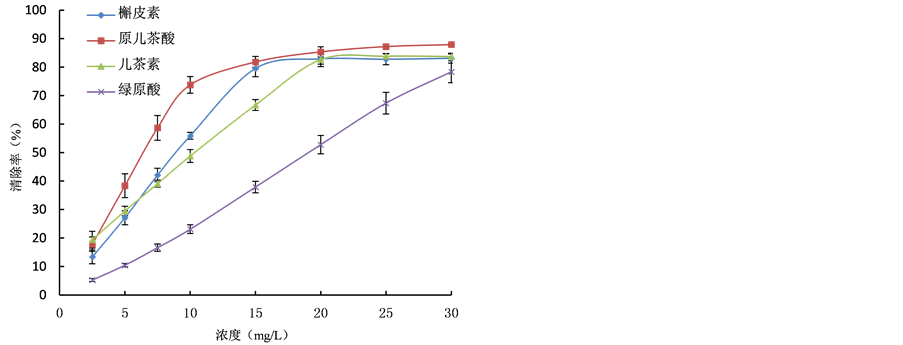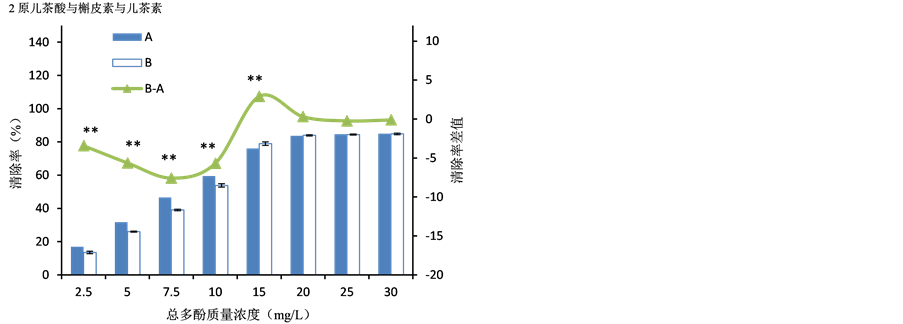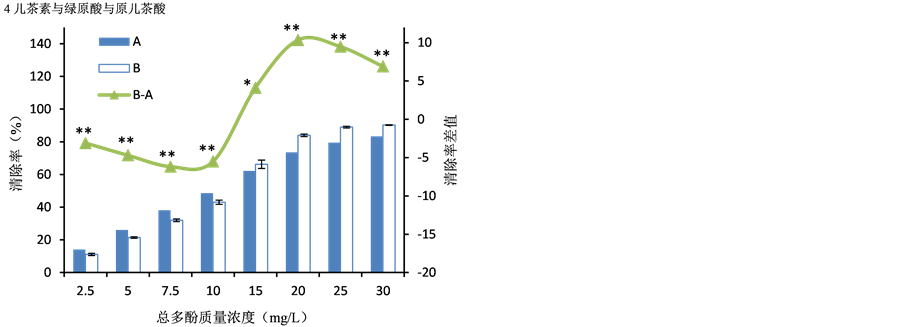1. 引言
含酚类化合物的食品对癌症、动脉粥样硬化、糖尿病、炎症性疾病等具有潜在的保护性作用 [1] 。酚类物质具有很强的体内和体外抗氧化活性,对自由基有效清除,是一种理想的天然抗氧化剂 [2] 。研究表明,酚类物质与维生素、磷脂、有机酸等其他抗氧化剂具有协同效应 [3] 。抗氧化剂之间的协同效应研究较深入的是常见抗氧化剂之间、抗氧化剂与增效剂之间的协同作用 [4] 。“抗氧化剂复合链”假说认为:不同脂/水溶性质、不同分子量、不同形态、不同活性强度、不同作用对象和位点的抗氧化剂有相互替代、补充、增强作用。本文根据酚类化合物的两类基本结构(C6-C3-C6及C6-C3型) [5] ,选取4种单体多酚化合物,分别研究四种单体多酚在不同混合体系中的体外抗氧化活性,为多酚类抗氧化制品的开发提取理论参考。
2. 材料与方法
2.1. 材料与试剂
儿茶素(纯度 ≥ 95%):上海阿拉丁试剂有限公司;槲皮素(纯度 ≥ 97%)、绿原酸(纯度 ≥ 98%)、原儿茶酸(纯度 ≥ 98%):上海瑞永生物科技有限公司;1,1-二苯基-2-苦基肼(DPPH):美国sigma公司;无水乙醇、铁氰化钾、三氯乙酸、氯化铁、磷酸氢二钠、磷酸二氢钠等均为分析纯:国药集团化学试剂有限公司。
2.2. 仪器与设备
722s可见分光光度计:湖南省计量检测研究所;CP214电子分析天平:上海豪斯仪器有限公司;KH-250DE型数控超声波清洗器:昆山禾创超声仪器有限公司。
2.3. 方法
2.3.1. 抗氧化活性的检测
DPPH自由基清除能力的测定:采用DPPH法,参考Wei-Wei Zhang等 [6] 的方法,DPPH自由基清除率计算公式:

式中:Ai为加入样品溶液和DPPH溶液的吸光度;Aj为加入样品溶液和乙醇的吸光度;A0为加入乙醇和DPPH溶液的吸光度。
总还原能力的测定:采用普鲁士兰法,参考赵艳红等 [7] 的方法,在700 nm波长处测定, ,吸光度值越高表示还原能力越强。
,吸光度值越高表示还原能力越强。
2.3.2. 单体多酚的抗氧化活性
所有多酚化合物样品均用无水乙醇配制,在一定质量浓度范围内分别进行抗氧化活性指标的测定。为方便多酚化合物之间抗氧化能力的比较,通过预实验,确定各多酚样品用于清除DPPH自由基能力的质量浓度范围为2.5~30 mg/L,用于测定总抗氧化能力的质量浓度范围为20~200 mg/L。
2.3.3. 单体多酚的协同抗氧化作用
根据多酚化合物的结构,选取绿原酸(C6-C3)、原儿茶酸(C6-C3)、槲皮素(C6-C3-C6)以及儿茶素(C6-C3-C6)进行抗氧化协同作用试验,将4种多酚化合物按等质量比分别进行两种、三种及四种多酚的混合,在两种组合中选择协同作用最优的一组再进行不同比例混合,分别在一定总多酚质量浓度梯度范围内测定各项抗氧化活性指标,协同、拮抗或加和作用取决于混合多酚实测值与预算值之间的差异大小 [8] ,差异不显著(P > 0.05)表示加和作用,差异显著(0.05 < P < 0.01)或极显著(P < 0.01)表示协同作用(实测值-预算值 > 0)和拮抗作用(实测值-预算值 < 0)。
2.3.4. 数据统计分析
试验中所有测试均进行3次重复,采用Excel和Origin软件对试验数据进行处理和统计分析,数据结果均以平均值 ± 标准差(  ± s)表示,实测值与预测值之间的差异性采用t检验法 [9] 分析。
± s)表示,实测值与预测值之间的差异性采用t检验法 [9] 分析。
3. 结果与分析
3.1. 单体多酚化合物抗氧化能力比较
单体多酚化合物的DPPH自由基清除率和总还原能力与其浓度之间的关系如图1。
由图1和表1、表2可知,不同多酚单体的总还原能力和DPPH自由基清除能力有明显差异,且与多酚浓度存在明显的剂量-效应关系。C6-C3型多酚(原儿茶酸和绿原酸)与C6-C3-C6型(槲皮素和儿茶素)在总还原能力和DPPH自由基清除能力方面与其碳链结构没有明显关系。
3.2. 两种单体多酚1:1混合的协同抗氧化作用
3.2.1. 清除DPPH自由基能力
由图2可知,在低浓度范围时,两种单体混合前的DPPH自由基清除率大于混合后的清除率,当浓度超过一定值后,绿原酸与原儿茶酸,槲皮素与儿茶素,两种单体混合后的DPPH自由基清除率分别小于或等于混合前的清除率,绿原酸与槲皮素,槲皮素与原儿茶酸,绿原酸与儿茶素,原儿茶酸与儿茶素,两种单体混合后的DPPH自由基清除率均大于混合前的清除率,尤其是绿原酸与槲皮素之间的协同清除能力极大地增强;两种单体多酚混合前后DPPH自由基清除率差异随浓度变化的显著关系见表3。
由表3可知,槲皮素-原儿茶酸,儿茶素-原儿茶酸,绿原酸-儿茶素,绿原酸-槲皮素,均呈现协同清除作用,可见,C6-C3-C6与C6-C3型多酚混合后,清除DPPH自由基能力增强;而具有相同结构类型的多酚,槲皮素-儿茶素,绿原酸-原儿茶酸,均呈现出拮抗清除作用。因此,如果两个单体多酚是同型结构,混合在一起表现为拮抗清除作用;如果是异型结构,则为协同作用。

Figure 1. Relation between DPPH radical scavenging activity (left) and total reducing power (right) of polyphenol monomer compound
图1. 多酚单体化合物的DPPH自由基清除率和总还原能力与浓度之间的关系

Table 1. Linear equation for scavenging effect on DPPH radicals versus concentration of polyphenols monomer compounds
表1. 单体多酚的DPPH自由基清除率与其浓度的线性关系

Table 2. Linear equation for total deoxidization capability versus concentration of polyphenols monomer compounds
表2. 单体多酚总还原能力与其浓度的线性关系

Table 3. Interaction analysis for phenolic mixtures (1:1, m/m) of scavenging effect on DPPH radicals
表3. 两种单体多酚混合前后DPPH自由基清除率差异的显著性分析
“*”代表实测值与预测值之间差异显著(0.01 < P < 0.05),“**”代表差异极显著(P < 0.01)
3.2.2. 总还原能力
两种单体多酚混合前后的总还原能力随浓度的变化关系如图3。
由图3可知,两种单体多酚混合前后的总还原能力均随浓度的增加而增强,而且混合后的总还原能力均比混合前强。两种单体多酚混合前后总还原能力差异随浓度变化的显著关系见表4。
由表4可知,槲皮素与儿茶素,绿原酸与原儿茶酸,绿原酸与儿茶素,混合前后总还原能力的差异不显著,槲皮素与原儿茶酸,只有在200 mg/L时,混合前后总还原能力的差异才是显著的,儿茶素与原儿茶酸,绿原酸与槲皮素,在较宽的浓度范围内均表现为极显著差异。因此,异型结构多酚的总还原能力也表现为协同作用,而同型结构多酚既无协同也无拮抗作用。
3.3. 三种单体多酚化合物复合协同抗氧化作用
3.3.1. 清除DPPH自由基能力
三种单体多酚等比例混合前后的DPPH自由基清除率随浓度的变化关系如图4。
由图4可知,三种单体多酚混合前后的总还原能力均随浓度的增加而增强,而且混合后的总还原能力均比混合前强。三种单体多酚混合前后清除DPPH自由基能力的差异显著性见表5。
由表5可知,与汤晓等 [10] 的结果类似,当含有较多B环羟基的黄酮类化合物混合时,更易发生拮抗作用。
3.3.2. 总还原能力
三种单体多酚混合前后的总还原能力差异比较如图5。
由图5可知,三种单体多酚混合前后的总还原能力均随浓度的增加而增强,而且混合后总还原能力均比混合前强。三种单体多酚混合前后总还原能力的差异显著性见表6。
由表6可知,3种多酚单体按质量比1:1:1混合后,在总还原能力体系中的相互作用与DPPH体系不同,儿茶素-绿原酸-原儿茶酸协同作用最强,在各个浓度下几乎都呈现出极显著的协同效果,其余组合协同作用从强至弱依次为槲皮素-儿茶素-绿原酸、原儿茶酸-槲皮素-儿茶素以及原儿茶酸-槲皮素-绿原酸,其中原儿茶酸-槲皮素-绿原酸在各个浓度下吸光度实测值与预测值之间均差异不显著,表现为加和作用。
3.4. 四种单体酚类化合物等比例复合协同抗氧化作用
四种单体多酚等质量比混合后DPPH自由基清除能力及总还原能力如图6。
由图6可知,四种单体多酚等质量比混合后DPPH自由基清除能力及总还原能力均与理论加和值存在明显差异。在清除DPPH自由基体系中,当总多酚质量浓度较低时(2.5~7.5 mg/L)拮抗作用显著,随着质量浓度的增加,协同作用明显增强,当浓度为20 mg/L时,清除率(%)实测值与预算值之差达到9.930,继续增加质量浓度,其协同作用缓慢减弱;在总还原能力体系中,混合多酚在各个质量浓度下基本都呈现出极显著的协同作用,且协同效果随质量浓度的增加而加强。抗氧化能力与混合多酚质量浓度存在明显的剂量-效应关系,且在一定范围内质量浓度与抗氧化指标线性关系良好,清除DPPH自由基体系中,在2.5~15 mg/L范围内,得到线性方程y = 4.996x − 1.39,R2 = 0.9996,EC50 = 10.29 ± 0.57,总还原能力体系中,在20~100 mg/L范围内,得到线性方程y = 0.006x + 0.003,R2 = 0.9984。为比较不同数量多酚等比例混合下的抗氧化协同效果,分别选取其中协同作用最强的组合进行比较,如图7。
由图7可知,不同数量多酚单体等质量比混合后的抗氧化协同作用差异明显,在清除DPPH自由基体系中,当质量浓度为20 mg/L时,三个组合的协同作用均最为显著,混合物中多酚数量越多,其协同作用越弱,绿原酸-槲皮素的协同效果明显优于其他两组,而在总还原能力体系中,多酚数量最多的组合协同效果较强,多酚数量为2、3的组合协同作用差别不大。

Table 4. Interaction analysis for phenolic mixtures (1:1, m/m) of total reducing power
表4. 两种单体多酚混合前后总还原能力差异显著性分析




Figure 4. Relationship between scavenging rate of DPPH radicals and the content for three phenolic mixtures
图4. 三种单体多酚混合前后的DPPH自由基清除率随浓度的变化关系

Table 5. Interaction analysis for phenolic mixtures (1:1:1, m/m/m) of scavenging effect on DPPH radicals
表5. 三种单体多酚混合物清除DPPH自由基能力的差异显著性
3.5. 不同比例绿原酸与槲皮素抗氧化协同作用比较
绿原酸与槲皮素以不同质量比混合后,其抗氧化协同作用效果如图8。
由图8可知,绿原酸与槲皮素以不同质量比混合后,其抗氧化协同作用有明显的差别,在清除DPPH自由基体系中,不同比例混合多酚的清除DPPH自由基协同作用趋势基本一致,绿原酸与槲皮素之比为

Table 6. Interaction analysis for phenolic mixtures (1:1:1, m/m/m) of total reducing power
表6. 三种单体多酚混合前后总还原能力差异的显著性分析




Figure 5. Total reducing power of phenolic-phenolic mixtures (1:1:1, m/m/m)
图5. 三种单体多酚等质量比混合物的总还原能力

Figure 6. DPPH radical scavenging activity (left) and total reducing power (right) of phenolic mixtures (1:1:1, m/m/m)
图6. 四种单体多酚等质量比混合物的DPPH自由基清除能力(左)及总还原能力(右)

 注:左图代表清除DPPH自由基能力,右图代表总还原能力。
注:左图代表清除DPPH自由基能力,右图代表总还原能力。
Figure 7. Synergistic antioxidant effect of different number of polyphenols mixed with equal mass raito
图7. 不同数量多酚等质量比混合下的抗氧化协同作用

Figure 8. Synergistic antioxidant effect of Chlorogenic acid and quercetin mixed with different quality raito
图8. 绿原酸与槲皮素不同质量比混合下的抗氧协同作用
3:1以及2:1时,协同作用最显著时的质量浓度为25 mg/L,而当其比例为1:1、1:2、1:3时,协同作用最显著时的质量浓度在20 mg/L处,以各比例下协同作用最强的点相比较,绿原酸与槲皮素协同效果由强至弱的比例依次为1:1、2:1、3:1、1:2、1:3;在总还原能力体系中,不同比例混合多酚的总还原能力协同作用均随质量浓度的增加而升高,以200 mg/L质量浓度下的协同效果相比较,协同作用由高到低的比例依次为1:1、2:1、1:2、3:1、1:3,该结果与DPPH自由基清除体系相似。由此可见,绿原酸与槲皮素等质量比时抗氧化协同作用最强,高绿原酸比重的组合协同作用强于高槲皮素比重的组合,槲皮素比重越高,其协同作用越弱。
4. 结论
综上所述,多酚单体化合物的抗氧化能力顺序为原儿茶酸 > 槲皮素 > 儿茶素 > 绿原酸。
单体多酚等质量比两两复配下,绿原酸-槲皮素在两种抗氧化体系中协同作用最强,两种多酚单体之间的抗氧化协同或拮抗作用与其结构类型有关,不同结构类型的多酚组合更易表现出协同作用,而结构类型相同的多酚组合则拮抗作用更明显;三种单体多酚等质量比复配下,在DPPH体系中,C6-C3型多酚较多的组合相比于C6-C3-C6型多酚较多的组合其协同作用更加显著,但该规律在总还原能力体系中不明显;多酚化合物之间抗氧化的协同效应与其数量有关,且在不同抗氧化体系中有一定的差异,DPPH体系中,多酚化合物数量越多,其协同作用越弱,而在总还原能力体系中多酚数量最多的组合协同效果最强;多酚单体之间的比例对抗氧化协同效果也有影响,绿原酸与槲皮素等质量比时抗氧化协同作用最强,绿原酸比重较高时协同作用较强,槲皮素比重越高,其协同作用越弱;绿原酸、原儿茶酸、槲皮素以及儿茶素4种酚类化合物的任意组合在两种抗氧化体系中的相互作用规律相同,DPPH体系中,当质量浓度较低时,多酚之间协同作用很弱,甚至出现拮抗作用,而浓度升高到一定程度后协同作用迅速增加,再增加浓度协同作用则呈现减弱的趋势,总还原能力体系中,协同作用随着质量浓度的增加而增强,由此可以看出,混合物中各多酚在单体状态下的抗氧化能力相差越大,协同作用越强,而质量浓度与协同作用没有直接的联系。
基金项目
校企合作项目(编号:1017DS0400)。海南省重大科技专项,项目编号:ZDKJ2016003-02。
*通讯作者。